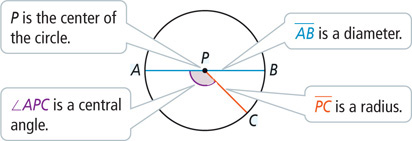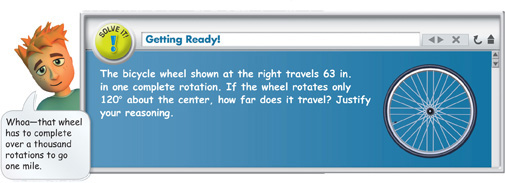10-6 Circles and Arcs
Objectives
To find the measures of central angles and arcs
To find the circumference and arc length
 Lesson Vocabulary
Lesson Vocabulary
- circle
- center
- diameter
- radius
- congruent circles
- central angle
- semicircle
- minor arc
- major arc
- adjacent arcs
- circumference
- pi
- concentric circles
- arc length
- congruent arcs
In a plane, a circle is the set of all points equidistant from a given point called the center. You name a circle by its center. Circle P ((P) is shown below.
A diameter is a segment that contains the center of a circle and has both endpoints on the circle. A radius is a segment that has one endpoint at the center and the other endpoint on the circle. Congruent circles have congruent radii. A central angle is an angle whose vertex is the center of the circle.

Essential Understanding You can find the length of part of a circle's circumference by relating it to an angle in the circle.
An arc is a part of a circle. One type of arc, a semicircle, is half of a circle. A minor arc is smaller than a semicircle. A major arc is larger than a semicircle. You name a minor arc by its endpoints and a major arc or a semicircle by its endpoints and another point on the arc.

Table of Contents
- 6-1 The Polygon Angle-Sum Theorems
- 6-2 Properties of Parallelograms
- 6-3 Proving That a Quadrilateral Is a Parallelogram
- 6-4 Properties of Rhombuses, Rectangles, and Squares
- 6-5 Conditions for Rhombuses, Rectangles, and Squares
- 6-6 Trapezoids and Kites
- 6-7 Polygons in the Coordinate Plane
- 6-8 and 6-9 Coordinate Geometry and Coordinate Proofs





